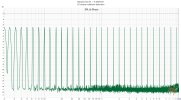ReDFoX
Member
Hi everybody! @NTTY's recent CD players measurements sparkled an interest in me, so I tried to be trendy and measure my disc playing devices.
Attention: I'm a noob at measuring things (at least now) + English isn't my native language (as you can tell by location), so, sorry in advance)
Well, I forgot to take any fancy pictures of my unit (silly fox moment), so I dug up an ancient photo of my system (yes, I was using a VHS deck for audio recording). The player itself is sexy (although I prefer NAD industrial design)and I would lick every millimeter of that faceplate

Unfortunately, a few years ago, this CD-67 developed a ring crack (is this the correct term?) on RCA out, so I took it apart and resoldered terminals. Here are some photos during process:




Let's begin our quick dive! I'm well-aware of this thread, it was created just hours after I finished with my test CD...
All signals were generated with REW.
CD-67 was fed into line input of my E-MU1616 at 192kHz sampling rate (E-MU has ultrasonic noise, so I wouldn't show anything above 48k).
Analysis settings, unless said otherwise:

Yeah, that looks kinda nice, especially for that price and age. CD-67 easily clears 16bit threshold!
Next up is multitone (FFT length is 512K):

Again, no signs of any kinds of excessive distortion and mains leakage.
A start of a measurement sweep I burnt onto CD got corrupted somehow (I should've added a silence before it), so I used 100Hz+ portion. Still, it shows surprisingly flat FR! My dad and I were convinced that this 67 model has some kind of soft sound and I expected a slow roll-off filter with a dropoff at HF, but no, this thing's flat! That's crazy, since I literally heard this sucker play softer and richer than my Pioneer DVD...

But really, what about stop band length, antialiasing filter attenuation and out of band performance? 255 averages were used in this test

Ehh, attenuation is mediocre, to say politely, but I don't really care about that

Well, yeah, it's unimpressive, but expected. Not a concern, IMO...
Jumping onto IMD distortion tests!
CCIF shows, again, a deficiency in out of band atenuation

SMPTE shows quite a clear spectrum (256k FFT):

Jitter performance is also nice, well below audibility (256k FFT again):

Single tone THD sweep is showing some rise in distortion at HF, but that's mediocre filter's fault, I suppose

Here are manufacturer's specs:

I got 0.0006% or 0.003% THD, if we use THD+N. Well, I was prepared to see something horrible, but this thing delivers! This isn't some top of the line model, but it's audibly transparent (as far as I can tell) and costs ~100usd, here, in Russia.
Attention: I'm a noob at measuring things (at least now) + English isn't my native language (as you can tell by location), so, sorry in advance)
Well, I forgot to take any fancy pictures of my unit (silly fox moment), so I dug up an ancient photo of my system (yes, I was using a VHS deck for audio recording). The player itself is sexy (although I prefer NAD industrial design)
Unfortunately, a few years ago, this CD-67 developed a ring crack (is this the correct term?) on RCA out, so I took it apart and resoldered terminals. Here are some photos during process:
Let's begin our quick dive! I'm well-aware of this thread, it was created just hours after I finished with my test CD...
All signals were generated with REW.
CD-67 was fed into line input of my E-MU1616 at 192kHz sampling rate (E-MU has ultrasonic noise, so I wouldn't show anything above 48k).
Analysis settings, unless said otherwise:
- 32k FFT
- 8 averages
- Dolph-Chebyshev 200 window
- 0% overlap
Yeah, that looks kinda nice, especially for that price and age. CD-67 easily clears 16bit threshold!
Next up is multitone (FFT length is 512K):
Again, no signs of any kinds of excessive distortion and mains leakage.
A start of a measurement sweep I burnt onto CD got corrupted somehow (I should've added a silence before it), so I used 100Hz+ portion. Still, it shows surprisingly flat FR! My dad and I were convinced that this 67 model has some kind of soft sound and I expected a slow roll-off filter with a dropoff at HF, but no, this thing's flat! That's crazy, since I literally heard this sucker play softer and richer than my Pioneer DVD...
But really, what about stop band length, antialiasing filter attenuation and out of band performance? 255 averages were used in this test
Ehh, attenuation is mediocre, to say politely, but I don't really care about that
Well, yeah, it's unimpressive, but expected. Not a concern, IMO...
Jumping onto IMD distortion tests!
CCIF shows, again, a deficiency in out of band atenuation
SMPTE shows quite a clear spectrum (256k FFT):
Jitter performance is also nice, well below audibility (256k FFT again):
Single tone THD sweep is showing some rise in distortion at HF, but that's mediocre filter's fault, I suppose
Here are manufacturer's specs:
I got 0.0006% or 0.003% THD, if we use THD+N. Well, I was prepared to see something horrible, but this thing delivers! This isn't some top of the line model, but it's audibly transparent (as far as I can tell) and costs ~100usd, here, in Russia.

